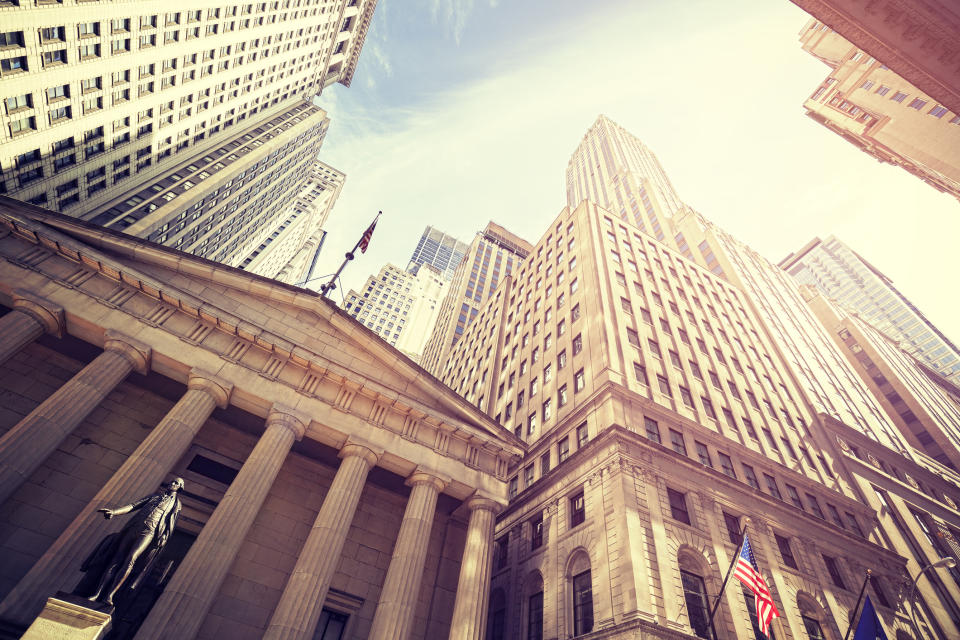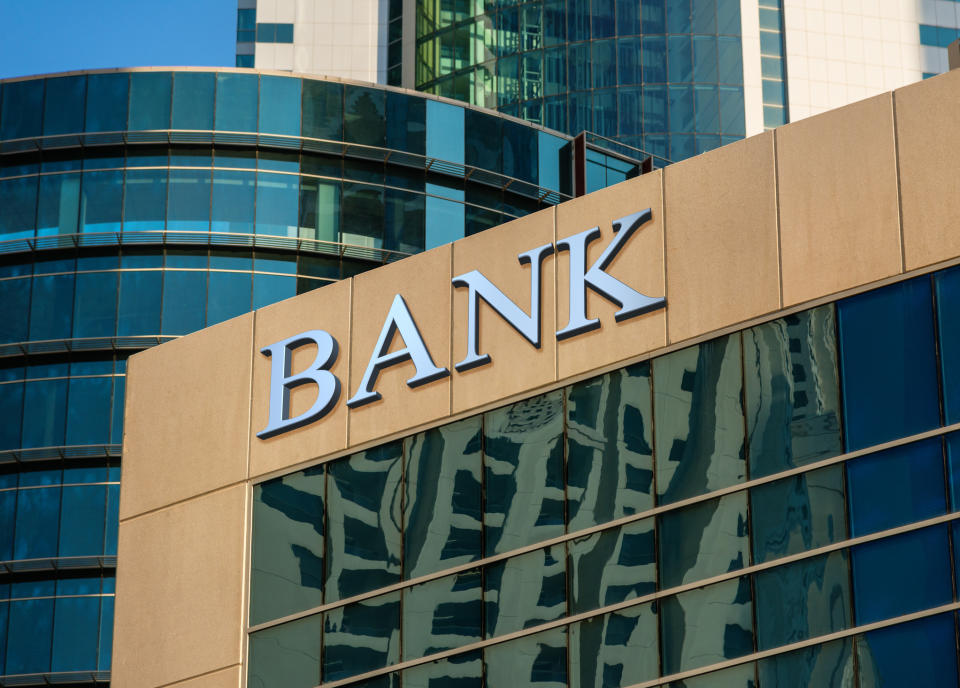Top Financial Stocks to Buy in 2019
The financial sector of the stock market is made up of companies that provide a variety of financial services to commercial and consumer customers, including:
Banks and credit unions
Credit card issuers and networks
A variety of other financial services companies.
The financial sector constitutes about 13% of the S&P 500 index, making it the third largest in the entire index. It should be noted that real estate investment trusts, or REITs, used to be included in this sector but were removed in 2016.

The financial sector plays a crucial role in the economy, providing important financial services to businesses and consumers. Image source: Getty Images.
Why is the financial industry important?
In many ways, a sound economy requires a healthy financial sector. Consider: Without banks and other financial institutions, there would be no capital for entrepreneurs to get their start-ups off the ground or for established businesses to undertake expensive expansion projects. The financial sector provides the mortgages that make home ownership attainable to more than just the wealthy elite. Without insurance companies, natural disasters and big medical bills would threaten to wipe out individuals and businesses alike every time they struck.
Let's take a closer look at some of the industries within the financial sector and the headwinds and tailwinds facing each before determining which bank and financial stocks rise to the top.
How should I invest in banks?
There are three broad types of banks you can invest in. We'll start with the simplest.
Commercial or retail banks lend money out at higher interest rates than the interest rates they pay to depositors. For instance, a bank might pay out 3% interest to customers who open up a savings account at their institution. The bank might then loan out that money at a 6% interest rate to homeowners who need a mortgage to buy their first home. The spread between the two interest rates is known as the net interest margin. Generally speaking, the wider the spread, the more profitable the bank's economic activity is.
To widen their spread, banks either need to find depositors who are willing to take lower interest rates to park their cash or borrowers who are willing to pay higher interest rates. This is a delicate balancing act that can quickly become a double-edged sword. If banks set excessively low interest rates on savings vehicles -- such as savings accounts or certificates of deposit (CDs) -- they run the risk of attracting fewer depositors. If they set their interest rates on loans too high, they run the risk of attracting only high-risk borrowers, who traditionally default at higher rates on their loans. Examples of commercial banks include U.S. Bancorp and Wells Fargo.

Banks make money by lending money out at higher interest rates than the interest rates they pay to depositors. Image source: Getty Images.
Investment banks, meanwhile, provide services to corporations such as facilitating mergers and acquisitions (M&A) or initial public offerings (IPOs), processing corporate debt, or handling other complex financial transactions. They also perform services such as asset management and usually provide advisory services for fees. Two well-known examples of such banks include Goldman Sachs and Morgan Stanley.
Finally, universal banks perform the functions of both commercial and investment banks. Examples include some of the largest banks in the world, such as Bank of America, Citigroup, and JPMorgan Chase.
Besides the net interest margin, there are three other figures to look at when evaluating banks as potential investments.
Return on assets (ROA): This metric measures a company's profit (or net income), which is all of its earnings after all the expenses are subtracted, relative to its total assets. It is found by dividing net income by total assets (and multiplying it by 100 if you want to express it as a percentage). Generally speaking, investors want this to be greater than 1% when looking at banks.
Return on equity (ROE): This formula measures a company's profitability compared to its shareholders' equity. Shareholders' equity is the investors' interest in the company and can be found by subtracting a company's liabilities from its assets. The higher the ROE, the more efficient a company is at generating profits. ROE is determined by dividing net income by shareholders' equity (and, again, multiplying by 100 to express as a percentage). For banks, investors usually want to see a figure exceeding 10%.
Efficiency ratio: This formula is relatively easy, but it tells us a lot. To find this figure, divide noninterest expenses -- basically the operating costs of a bank -- by its net revenue and multiply by 100. The lower the better, and a good rule of thumb is to look for a ratio under 60%. This is so important because it tells investors how much money a bank has left over to set aside for loan losses, pay dividends, and buy back stock. It also makes for a good bellwether of how well a bank underwrites loans.
How should I invest in insurance companies?
Consumers need a wide range of insurance policies to financially safeguard themselves in today's world. With rising medical costs, health insurance is an absolute necessity. Drivers need car insurance to protect themselves from auto theft and accidents. Parents and caretakers should consider life insurance to ensure their loved ones are provided for in case of an untimely death.

Insurance protects consumers from unfortunate events such as fires, natural disasters, and theft. Image source: Getty Images.
Some insurance companies provide policies for all of these circumstances and sell them together in bundles. Other insurance companies specialize in a specific niche. No matter what type of insurance company is being considered for an investment, however, there are one key concept and one important ratio investors need to know and understand.
Key insurance concept: Float
Float is the money insurance companies possess in between being paid premiums and paying out benefit claims. While all insurance companies invest their float, they can do so in a variety of different ways. Aflac, for instance, pays supplemental insurance claims for things such as work injuries and cancer. It invests its float very conservatively in domestic and foreign bonds. Meanwhile, Berkshire Hathaway, Warren Buffett's chosen vehicle for investing success, has used the float from its insurance companies to acquire other businesses and invest in stocks.
Key insurance formula: The combined ratio
The combined ratio informs us whether insurance companies make profits from underwriting policies. When insurance companies make money from the premiums they collect before they invest the float, that's generally a winning formula for investors. To find the combined ratio, add losses and expenses and divide the sum by the earned premiums. The answer is multiplied by 100 to be expressed as a percentage:
Combined ratio = (Losses + Expenses) / Earned premiums x 100
If this ratio is below 100%, the company is making a profit from its insurance activities.
Let's walk through a real-world example so we can better understand how the combined ratio works. To calculate Aflac's full-year combined ratio, we will need to look at its 10-K, the annual report it files with the Securities and Exchange Commission (SEC). We must add the net of Aflac's "benefit and claims" with "total acquisition and operating expenses" for the numerator. The denominator can be found by adding the full-year Aflac Japan and Aflac U.S. earned premiums. That gives us this equation:
[(Benefit and claims) + (total acquisition and operating expenses)] / (U.S. and Japan earned premiums)
12,181 + 5,468/18,315 = 0.964
Aflac is a company I follow on a regular basis and have owned at different times during my investment career. While I cannot say I have faithfully calculated its combined ratio every quarter, I have done it many times and have never found it to exceed 100%. That means Aflac makes a profit from its earned premiums, before any investment income from the float is taken into account. This is exactly what investors should look for in an insurance company.
How should I invest in the financial services industry?
The financial services industry is made up of a long list of companies that perform a wide range of tasks that often blur the line between the tech and financial sectors, making the inclusion and exclusion of certain companies vague and nebulous at times. As financial technology -- or fintech -- encroaches more and more on traditional financial companies' turf, this line becomes even more blurred.
Again, the companies in this sector perform such a diverse collection of tasks that it is almost easier to list a few examples than to try to describe the range of companies included. So, for example...
Moody's and S&P Global are credit ratings agencies that rate corporate and government debt offerings.
Intercontinental Exchange and Nasdaq provide marketplaces where investors can buy and sell securities quickly and securely.
E*TRADE Financial and TD Ameritrade Holding provide brokerage services through which investors can buy and sell equities online.
Mastercard and Visa provide vast payment networks that move funds quickly and securely from consumers' bank accounts to merchants' accounts when their branded products are used to facilitate purchases either online or at the point of sale.
Q2 Holdings provides technological expertise and consulting services to small and medium-sized banks that are not able to develop all of today's digital bells and whistles in-house.
BlackRock is an investment management firm with $6.3 trillion of assets under management.
What is the financial industry's single greatest risk?
The last thing you need to know before investing in the financial sector is how much exposure companies have to credit liabilities -- in other words, debt. Some companies, even those with seemingly similar business models, have very different credit exposure risks. This becomes especially important during economic downturns, when workers are laid off or have difficulty finding work, making it hard for them to meet their debt obligations. When this happens, the banks or financial institutions that loaned this money to consumers can be left holding the bag.

Debt is the most dangerous risk investors face when investing in the financial sector. Image source: Getty Images.
It is also important to understand the difference between secured and unsecured debt. Secured debt is debt that is secured by collateral (also known as hypothecation). In other words, if borrowers stop making scheduled payments on their loans, the bank can come in and seize any assets that were acting as collateral. Examples of secured debt include mortgages and auto loans. This type of debt can be assigned lower interest rates because it is much less risky to the lender than unsecured debt, where there is no collateral. Examples of unsecured debt include credit card and personal loans. Financial institutions are compensated for this risk by charging higher interest rates on any unsecured debt they issue.
Wells Fargo, by far the largest domestic mortgage lender, does not face as much risk from loan defaults, then, as financial institutions whose primary loans are in the credit card industry. This bears out in the numbers. For instance, the 2017 Federal Reserve stress test, an analysis of how different banks would respond to adverse economic conditions, revealed that institutions such as Capital One Financial and Discover Financial Services would have to write off the largest percentage of loans if another financial crisis were to occur. That's because, as a percentage of assets, the two are the largest lenders of unsecured debt.
When investing in the financial sector, it is important to know how much debt banks and other financial lenders are exposed to and, just as important, the kind of debt to which they are exposed.
What are the best financial investments for 2019?
While there are a variety of ways to play the financial sector as an investor, these are my picks for the best financial stocks to buy in 2019.
Financial Company | Bullish Elevator Pitch | Market Cap |
|---|---|---|
American Express (NYSE: AXP) | Highest-quality cardholders in credit card industry | $84.1 billion |
Bank of America (NYSE: BAC) | Big bank that benefits from scale and a large mobile presence | $275 billion |
Berkshire Hathaway (NYSE: BRK-A) (NYSE: BRK-B) | Uses float from insurance companies to fund acquisitions and investments | $480 billion |
Broadridge Financial (NYSE: BR) | Near monopoly on its core services of providing proxy communications and processing trades for publicly traded companies | $11.5 billion |
JPMorgan Chase (NYSE: JPM) | Large bank that benefits from scale and has a high return on equity | $336 billion |
Mastercard (NYSE: MA) | Large payments network that enjoys a wide economic moat | $202 billion |
Moody's (NYSE: MCO) | Credit ratings agency that enjoys a moat based on its brand and a regulated industry | $28.6 billion |
Q2 Holdings (NYSE: QTWO) | Operates a sticky ecosystem in a large total addressable market | $2.2 billion |
Visa (NYSE: V) | Largest payments network; enjoys a vast moat from scale with high operating margin | $302 billion |
Market cap data: Google Finance
Let's take a closer look at some of these companies to see why they might make for such good investments in 2019...and beyond.
Why you should invest in American Express
After my warning that the biggest risk facing financial companies is their exposure to unsecured debt, it might seem odd to see American Express here. After all, American Express makes money almost exclusively from issuing credit cards. But no one does a better job of selecting quality borrowers and limiting loan losses than this company, making it the best lender in the industry. Over its last six quarters, Amex's net write-off rate, the percentage of delinquent loans that the company does not expect to collect, has not risen above 2.1%, a rate far lower than that of any of its peers such as Discover or Synchrony Financial.
American Express makes the vast majority of its revenue, about 60%, from the fees it charges to merchants every time an American Express card is swiped, literally or figuratively, at the point of sale. This figure -- known as discount revenue -- was nearly $6.2 billion in the company's most recent quarter, up from $4.5 billion at the beginning of 2017. That's about a 38% increase in less than two years.

American Express remains the best lender in the industry, with write-off rates that consistently fall below the industry's average. Image source: Getty Images.
Amex has managed to grow its largest revenue stream by consciously deciding to lower its discount rate, the amount of money it collects for each transaction. Since the beginning of 2017, Amex's average discount rate has decreased from 2.45% to 2.38%. Thanks to this lower rate, the card is now accepted by more merchants, meaning card members can use their cards for more purchases. While this lowers the amount it collects for each individual transaction, Amex cards are being used for more transactions, making the trade-off more than worthwhile.
In the company's third-quarter conference call, CEO Steve Squeri said investors can continue to expect to see investments made in increased merchant coverage:
[Y]ou will continue to see a focus on investing in coverage. And we believe that as we have invested in coverage here in the United States, that has made a huge difference...in discount revenue growth. ... So bottom line is, we're going to be investing for share and for scale as we continue moving forward.
The company is also making strides in its digital capabilities. Amex recently completed a partnership with PayPal Holdings, the digital wallet with more than 250 million active user accounts. The partnership will give American Express cards higher visibility on the platform and give cardholders more options for redeeming reward points. Amex also recently completed two fintech acquisitions. In October 2017, Amex purchased Cake, a start-up that specializes in digital payments at restaurants and bars. In 2018, the company performed an encore act when it acquired Mezi, an AI-powered personal assistant app for travelers.
With a focus on growing its largest revenue stream while smartly managing its debt, combined with a new recognition of the importance of digital capabilities in a fintech world, American Express seems like a good bet to produce market-beating returns over the next few years.
Why you should invest in JPMorgan Chase
Of all the domestic universal banks to consider, JPMorgan Chase might offer the most attractive returns going forward. It is consistently the most profitable of the "big four" banks, with a return on equity of 14% in its most recent quarter that easily exceeds the 10% threshold we look for. And while we should never blindly follow other investors, it gives us confidence to know that none other than Warren Buffett also likes the bank, initiating a $4 billion stake in it in 2018.
JPMorgan is consistently on the cutting edge of fintech, not afraid to make big investments in its digital and mobile offerings, boasting 32.5 million active mobile users. Chase also recently launched Finn by Chase and You Invest. Finn is an all-mobile bank offering designed to appeal to millennials. It comes with no monthly fees and free budgeting and saving tools. You Invest is a new digital investing option that comes with 100 free trades for new accounts and then only charges $2.95 for commission fees thereafter. It also comes with personally tailored portfolios for new investors getting started. In Chase's 2018 third-quarter conference call, when asked about the strategy behind You Invest, CFO Marianne Lake answered, "Clearly, we are trying to add products and capabilities and value to our existing clients in an effort to continue to drive loyalty and engagement, and also earn more share of their wallet, but we do think that the proposition is compelling, and that the pricing is disruptive, and we should also expect over time to be able to attract new accounts."
Why you should invest in Mastercard and Visa
Mastercard and Visa feature such nearly identical business models that it would be difficult to leave one off at the expense of the other. Both act as a toll road for money between the consumer's bank and the merchant's bank after a purchase is made using one of these companies' cards or digital products. For providing this service, Mastercard and Visa collect fixed fees and a percentage of the total amount of the sale. While these fees are small, they quickly add up due to the vast size and scale of both companies.

Both Mastercard and Visa enjoy a vast network effect with banks, consumers, and merchants. Image source: Getty Images.
As electronic and digital payments rise, the use of their products can only increase, placing Mastercard and Visa on the right side of several large global trends. After all, there are not too many online sales being completed these days with cash or personal checks. This includes both online sales and mobile payments. In fact, at a recent investor conference, Visa CFO Vasant Prabhu said that a Visa product was twice as likely to be used in an e-commerce transaction as a traditional retail sale.
Visa, the larger of the two companies, now has 3.3 billion cards issued that were used to make 32.8 billion processed transactions in its most recent quarter. Mastercard has 2.5 billion cards that were used for 18.8 billion transactions. Both have enviable operating margins: Visa 66%, Mastercard 59%. These high margins allow the companies to make acquisitions, invest in international opportunities, and return money to shareholders via dividends and buybacks. While the dividend yields are still small, both companies are consistently raising their dividends by large percentages each year.
Why you should invest in Moody's
As a credit ratings agency that grades different types of debt equities, Moody's enjoys two distinct types of economic moats, or sustainable competitive advantages. The first is regulatory approval. Not just any company can legally rate corporate and government bonds, financial institutions, and fixed-income funds in most developed economic markets. In the United States, only 10 companies are currently approved by the Securities Exchange Commission (SEC) to do so. In Europe, the EU recognizes 26 credit rating agencies. The number of bureaucratic hoops these companies must jump through in either market to be recognized makes it extremely challenging for new companies to enter and disrupt the space.
But even these numbers don't tell the true tale of competition in this space, which leads us to Moody's second moat. Moody's is one of three credit ratings agencies -- the others being S&P Global and Fitch Ratings -- known collectively as the "Big Three." These three agencies, rightly or wrongly, have such esteemed reputations that they dominate the industry with 90%-plus market share in the U.S. and Europe.
Moody's dominant position in the credit ratings industry provides it with a secure cash cow, funding its Moody's Investors Service division. This segment accounts for approximately 60% of Moody's total revenue and sports a sky-high operating margin, which came in at 55.1% in its most recent quarter. This segment's revenue is lumpy, however, and cannot be relied upon to grow consistently year over year, so Moody's uses the profits from this division to fund growth in its other division, Moody's Analytics.
Moody's Analytics provides financial research, data, and analytical tools to businesses. While the operating margin is lower than the Investors Service division, it is still a respectable 26.4%. More important, however, it is growing faster and more reliably, giving Moody's a channel to reinvest its profits in the business.
Why you should invest in Q2 Holdings
Q2 helps smaller banks and credit unions to compete with the industry's behemoths, enabling them to offer the same type of cloud-based, virtual offerings that big banks can offer. This allows regional and community financial institutions (RCFIs) to better compete for today's consumers, who expect to be able to bank however (from any device) and whenever (24/7 access to digital banking services) they want. Q2 offers several different platforms that RCFIs can subscribe to, often paid monthly over a five-year contract, that provide tools for fraud prevention, data analysis, digital account openings, and mobile banking solutions.
CEO Matt Flake firmly believes in his company's mission of helping local banks and that the world is a better place when there are more than just a few big banks to choose from. In an exclusive interview with the Motley Fool, Flake said:
[W]e put the mission around it, which is strengthening communities by building stronger community financial institutions. That drives our culture. Our mission drives our culture in that anything we build or do, we say, "This is going to be good for community banks or credit unions." And if it's good for them, it's going to be good for our country, because 75% of the small-business loans goes through these financial institutions. We believe that financial choice is critical. Financial empowerment is based on having a lot of options.
Q2 grew revenue 24% in 2018, increasing its gross margin for the fifth straight year, and it currently has 12.8 million registered users through its contracts with RCFIs. While this registered user base is large, it is just a tiny slice of the number of domestic consumers who bank at one of the country's 11,000-plus RCFIs. While it pursues this large market, Q2's current customer base is unlikely to leave. A small bank that relies on Q2's platforms to meet all of its technological needs would find it exceedingly difficult to find comparable service elsewhere, giving Q2 an extremely sticky ecosystem.
More From The Motley Fool
Matthew Cochrane owns shares of JPMorgan Chase, Mastercard, Moody's, and PayPal Holdings. The Motley Fool owns shares of and recommends Berkshire Hathaway (B shares), Broadridge Financial Solutions, Intercontinental Exchange, Mastercard, and PayPal Holdings. The Motley Fool owns shares of Moody's, Q2 Holdings, and Visa. The Motley Fool recommends Aflac and Nasdaq. The Motley Fool has a disclosure policy.

 Yahoo Finance
Yahoo Finance 